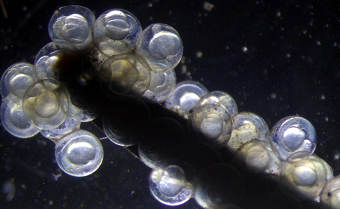They’re a keystone species in the food web. If you look at birds and marine mammals in the Pacific, that’s what they’re eating. They also aren’t resident in San Francisco Bay for most of the year. They’re an ocean fish that spawns in the bay, so it’s a crucial habitat for the eggs and young fish. Each year, there are thousands of fish that come into the bay to lay thousands of eggs. Herring have sticky eggs and they attach them to vegetation on the shoreline.
When there's an oil spill from a ship, that oil floats, so it washes up on the shoreline. Chemicals from the oil dissolve in the water and those chemicals are very readily taken up by a herring embryo.
What does the oil do to developing herring?
We knew from the Exxon Valdez spill that herring embryos are very sensitive to oil. It damages the hearts of developing fish. That’s what we were expecting to see in San Francisco Bay. We looked at herring embryos growing in the tidal zone and we found that in the subtidal areas, the lower areas, the embryos were developing heart defects through 2010. There was still a lingering effect of the oil a full two years later.
But in February 2008, a lot of herring spawned in shallower water. And when we looked at those eggs, instead of seeing the cardiac effects, they were almost all completely dead. And not just dead, but falling apart. So that was the surprising finding.
Why was it surprising to find dead eggs?
We know that crude oil doesn’t usually kill the eggs outright. It produces heart defects, which kill the fish later. So it was unusual to find dead eggs in shallower water.
What’s different in shallower water is that there’s more exposure to sunlight. We suspect that there was some interaction between the bunker oil compounds and UV light that makes it more toxic. There’s something in the bunker oil that produces different effects than crude oil.
What is bunker oil and how is it different from crude oil?
It’s what fuels all of these large ships. It’s a mix of residual fuel oil and diesel. That residual fuel is the dregs of crude oil. When crude oil is taken to a refinery, gasoline and other petrochemical products are removed, and what’s left is the tarry residue. They take it and burn it in these big ships.
Bunker oil is a very highly concentrated end-product derived from crude oil. So it’s chemically much more complex. And what the chemical analysis showed us is that the usual chemical suspects that we were looking for weren’t really there at levels that would explain all the mortality. So we really think there are other toxic chemicals that aren’t routinely measured in the context of an oil spill.
What’s the impact of your research?
It’s really about the forensic chemistry and what the chemists need to do when they’re analyzing the impact of an oil spill. Oil is immensely complex. It has thousands of chemicals. And all this shows us is that we really don’t know what the biological effects of these chemicals are when they’re released in the environment. That’s probably the biggest lesson.
